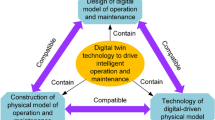Abstract
Maintenance is essential to guarantee the availability of any technical equipment, but is the dominant cost factor during the equipment’s operating phase. In this chapter it is shown how Digital Product Memories (DPMs) can be used to optimize different maintenance tasks. Therefore, the analysis is focused on the requirements of two domains: industrial manufacturing and automobiles.
Access this chapter
Tax calculation will be finalised at checkout
Purchases are for personal use only
Similar content being viewed by others
Notes
- 1.
We focus on wearing parts as a subcategory of spare parts, because only for wearing parts are all the described objectives fulfilled. The system is of course also applicable for nonwearing spare parts; thus, we use the term “wearing parts” only for applications not applicable for spare parts in general.
- 2.
ECU: Electronic Control Unit.
- 3.
Condition-Based Service (CBS) is a system in BMW series cars that calculates service intervals based on the usage (and thus the condition) of wearing parts; e.g., based on tire rotation and the braking pressure of each braking action, the abrasion of the brake pads is calculated.
- 4.
Sometimes several parts are in one box; e.g., for brake pads there are different serial numbers for the parts of one set of brake pads, which is referred to as the product.
- 5.
In series models today, a push-button in the instrument cluster is used to select a part of the CBS and re-initialize it to the standard value; e.g., brake pads are re-initialized to 50,000 km.
References
ABI Research, Near field communication (NFC)—interim technologies and devices, and NFC mobile handsets. Technical report, ABI Research, 2008. http://www.abiresearch.com/mobile/research/1000885#summary
G. Bandow, W. Martin (eds.), RFID in der Instandhaltung (Praxiswissen Service, Dortmund, 2010)
N. Bartneck, V. Klaas, H. Schönherr, Prozesse optimieren mit RFID und Auto-ID: Grundlagen, Problemlösung und Anwendungsbeispiele, vol. 1 (Publicis Kommunikationstag, Berlin, 2008)
Y.-J. Cho, F. Kuttig, M. Strassberger, J. Preißinger, A digital product memory architecture for cars, in SemProM—Foundations of Semantic Product Memories for the Internet of Things, ed. by W. Wahlster. Cognitive Technologies (Springer, Berlin, 2013)
P.H. Cole, D.C. Ranasinghe, Networked RFID Systems and Lightweight Cryptography: Raising Barriers to Product Counterfeiting, vol. 1 (Springer, Berlin, 2007)
S. Horn, A. Claus, J. Neidig, B. Kiesel, T. Hansen, J. Haupert, The SemProM data format, in SemProM—Foundations of Semantic Product Memories for the Internet of Things, ed. by W. Wahlster. Cognitive Technologies (Springer, Berlin, 2013)
B. Kiesel, J. Neidig, The block interface: accessing digital product memories, in SemProM—Foundations of Semantic Product Memories for the Internet of Things, ed. by W. Wahlster. Cognitive Technologies (Springer, Berlin, 2013)
A. Kröner, J. Haupert, J. de Gea Fernández, R. Steffen, C. Kleegrewe, M. Schneider, Supporting interaction with digital product memories, in SemProM—Foundations of Semantic Product Memories for the Internet of Things, ed. by W. Wahlster. Cognitive Technologies (Springer, Berlin, 2013)
G. Meixner, A. Kröner, G. Kahl, A summary of end user feedback on digital product memories, in SemProM—Foundations of Semantic Product Memories for the Internet of Things, ed. by W. Wahlster. Cognitive Technologies (Springer, Berlin, 2013)
T. Nash, Counterfeit parts: a poor fit for your shop. MOTOR Magazine, January 2004. http://www.motor.com/MAGAZINE/Articles/012004_04.html
J. Neidig, T. Grosch, U. Heim, The Smart SemProM, in SemProM—Foundations of Semantic Product Memories for the Internet of Things, ed. by W. Wahlster. Cognitive Technologies (Springer, Berlin, 2013)
RFID im Blick, AutoID/RFID Handbuch 2011 (Verlag & Freie Medien, Amelinghausen, 2011)
RFID Journal Blog, RFID in maintenance and field services. http://www.rfidjournal.com/blog/entry/3994, January 2008
M. Schmitz, B. Brandherm, J. Neidig, S. Schachtl, M. Schuster, Interaction modalities for digital product memories, in SemProM—Foundations of Semantic Product Memories for the Internet of Things, ed. by W. Wahlster. Cognitive Technologies (Springer, Berlin, 2013)
T. Staake, E. Fleisch, Countering Counterfeit Trade: Illicit Market Insights, Best-Practice Strategies, and Management Toolbox, vol. 1 (Springer, Berlin, 2008)
R. Steffen, J. Preißinger, T. Schöllermann, A. Müller, I. Schnabel, Near field communication (NFC) in an automotive environment—use cases, architecture and realization, in Proceedings of the 2nd International IEEE Workshop on Near Field Communication, Monaco, April (2010), pp. 15–20. http://www.itestra.de/fileadmin/redaktion/publikationen/10_itestra_BMW_NFC_in_an_automotive_environment.pdf
W. Wahlster, The semantic product memory: an interactive black box for smart objects, in SemProM—Foundations of Semantic Product Memories for the Internet of Things, ed. by W. Wahlster. Cognitive Technologies (Springer, Berlin, 2013a)
W. Wahlster (ed.), SemProM—Foundations of Semantic Product Memories for the Internet of Things. Cognitive Technologies (Springer, Berlin, 2013b)
Author information
Authors and Affiliations
Corresponding author
Editor information
Editors and Affiliations
Rights and permissions
Copyright information
© 2013 Springer-Verlag Berlin Heidelberg
About this chapter
Cite this chapter
Neidig, J., Preißinger, J. (2013). A SemProM Use Case: Maintenance of Factory and Automotive Components. In: Wahlster, W. (eds) SemProM. Cognitive Technologies. Springer, Berlin, Heidelberg. https://doi.org/10.1007/978-3-642-37377-0_22
Download citation
DOI: https://doi.org/10.1007/978-3-642-37377-0_22
Publisher Name: Springer, Berlin, Heidelberg
Print ISBN: 978-3-642-37376-3
Online ISBN: 978-3-642-37377-0
eBook Packages: Computer ScienceComputer Science (R0)




